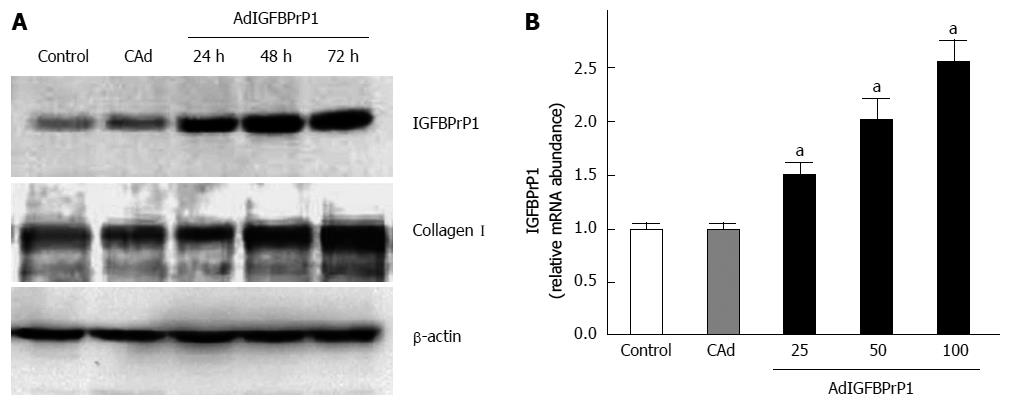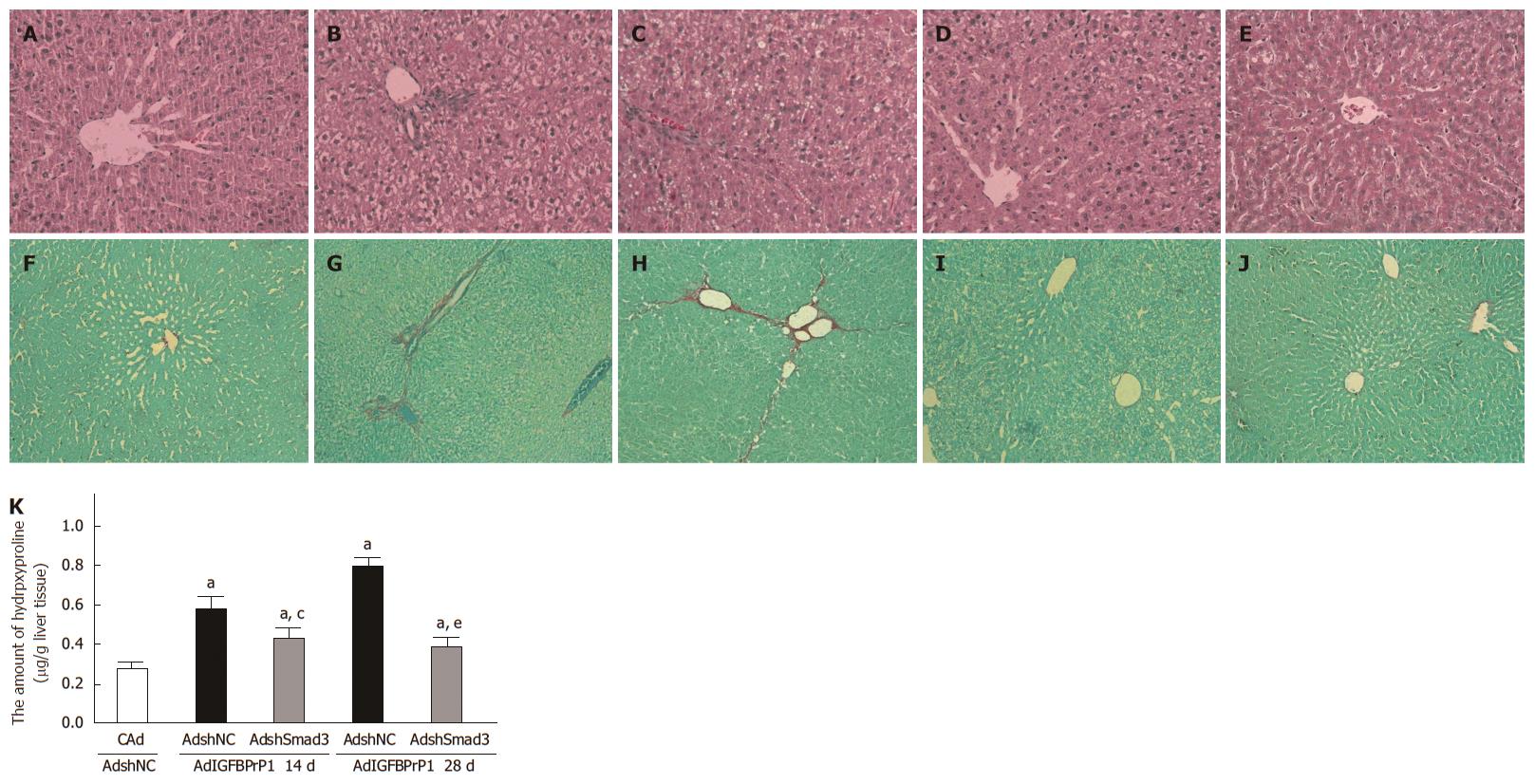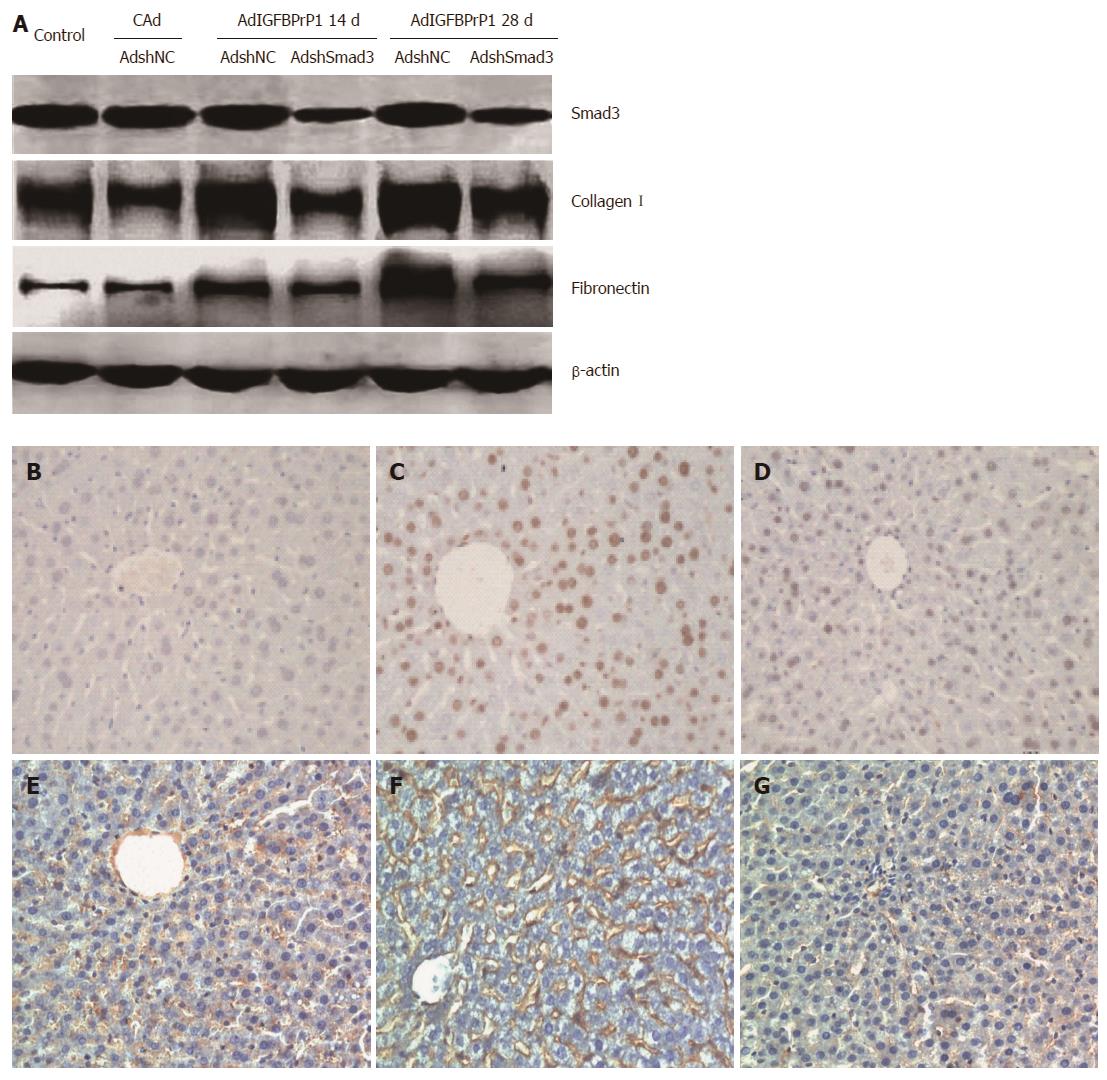Copyright
©2014 Baishideng Publishing Group Inc.
World J Gastroenterol. Jun 7, 2014; 20(21): 6523-6533
Published online Jun 7, 2014. doi: 10.3748/wjg.v20.i21.6523
Published online Jun 7, 2014. doi: 10.3748/wjg.v20.i21.6523
Figure 1 Insulin-like growth factor binding protein-related protein 1 overexpression induces extracellular matrix production in hepatic stellate cell-T6 cells.
Hepatic stellate cell-T6 cells were infected with cDNA (cAd) or adenovirus vector carrying insulin-like growth factor binding protein-related protein 1 (IGFBPrP1) (AdIGFBPrP1) for 24, 48 and 72 h at a multiplicity of infection of 100. Cell lysates were prepared from each culture. A: IGFBPrP1 and collagen I protein expression was detected by Western blot; B: IGFBPrP1 mRNA level was analyzed by real-time polymerase chain reaction. Data are expressed as mean ± SD (n = 4 per group). aP < 0.05 vs the levels in the control group.
Figure 2 Insulin-like growth factor binding protein-related protein 1 overexpression stimulates Smad2/3 phosphorylation in hepatic stellate cell-T6 cells.
A: Total and phosphorylated Smad2/3 protein expression in hepatic stellate cell-T6 (HSC-T6) cells was examined by Western blot 48 and 72 h after cDNA (cAd) or adenovirus vector carrying insulin-like growth factor binding protein-related protein 1 (IGFBPrP1) (AdIGFBPrP1) transfection (multiplicity of infection = 100); B: P-Smad2/3 content normalized with total Smad3 content in cAd or AdIGFBPrP1-treated HSC-T6 cells. Data are expressed as mean ± SD (n = 4 per group). aP < 0.05 vs the levels in the control group.
Figure 3 Insulin-like growth factor binding protein-related protein 1-induced extracellular matrix expression is mediated through the Smad pathway in hepatic stellate cell-T6 cells.
Hepatic stellate cell-T6 (HSC-T6) cells were co-infected with adenovirus vectors containing shSmad3 (AdshSmad3) or shNC (AdshNC) and adenovirus vector carrying insulin-like growth factor binding protein-related protein 1 (IGFBPrP1) (AdIGFBPrP1). A: Expression of enhanced green fluorescent protein (EGFP) and red fluorescent protein (RFP) in HSC-T6 cells was visualized by confocal microscopy after treatment with AdshSmad3 (magnification ×200); B, C: Smad3 protein (B) and mRNA (C) expression in HSC-T6 cells was detected by Western blot and real-time polymerase chain reaction (RT-PCR) after treatment with different multiplicity of infection (MOI) of AdshSmad3, respectively; D, E: Smad3 protein (D) and mRNA (E) expression was detected by Western blot and real-time RT-PCR 72 h or 96 h after AdshSmad3 treatment (MOI = 100), respectively; F, G: Protein (F) and mRNA (G) expression of α-smooth muscle actin (α-SMA) and extracellular matrix in HSC-T6 cells was analyzed by Western blot and real-time RT-PCR 72 h after AdshSmad3 treatment (MOI = 100), respectively. Data are expressed as mean ± SD (n = 4 per group). aP < 0.05 vs the levels in the control group; cP < 0.05 vs the levels in cAd + AdshNC; eP < 0.05 vs the levels in AdIGFBPrP1 + AdshNC.
Figure 4 Smad2/3 expression in insulin-like growth factor binding protein-related protein 1-induced rat hepatic fibrosis.
Rats were injected with cDNA (cAd) or adenovirus vector carrying insulin-like growth factor binding protein-related protein 1 (IGFBPrP1) (AdIGFBPrP1) and sacrificed 28 d after injection. A-J: Protein expression of IGFBPrP1 in hepatocytes and hepatic stellate cells (HSCs) (arrows) in the livers of cAd-treated (A) and AdIGFBPrP1-treated (B) rats was evaluated by immunofluorescence; Histopathology (C, D) and collagen content (E, F) in the livers of cAd-treated and AdIGFBPrP1-treated rats were demonstrated by HE and Sirius Red staining; expression of total Smad2/3 (G, H) and phosphorylated Smad2/3 (I, J) in hepatocytes and HSCs (arrows) in the livers of cAd-treated and AdIGFBPrP1-treated rats was examined by immunohistochemistry (magnification × 400); K: Protein expression of total and phosphorylated Smad2/3 in the livers was examined by Western blot analysis; L: P-Smad2/3 content normalized with Smad3 content in the livers of the control, cAd or IGFBPrP1 group. Data are expressed as mean ± SD (n = 10 per group). aP < 0.05 vs the levels in the control group.
Figure 5 Adenoviral vectors containing shSmad3 ameliorated insulin-like growth factor binding protein-related protein 1-induced liver fibrosis.
Rats were sacrificed 14 and 28 d after injection with adenovirus vectors containing shSmad3 (AdshSmad3) or shNC (AdshNC) in the presence of cDNA (cAd) or adenovirus vector carrying insulin-like growth factor binding protein-related protein 1 (IGFBPrP1) (AdIGFBPrP1). Histopathology (A-E) and collagen content (F-J) in the livers were demonstrated by HE and Sirius Red staining (A, F: cAd + AdshNC; B, G: AdIGFBPrP1 + AdshNC 14 d; C, H: AdIGFBPrP1 + AdshSmad3 14 d; D, I: AdIGFBPrP1 + AdshNC 28 d; E, J: AdIGFBPrP1 + AdshSmad3 28 d; magnification × 200); K: The amount of collagen in rat livers was determined using the hydroxyproline assay. Data are expressed as mean ± SD (n = 10 per group). aP < 0.05 vs the levels in the cAd + AdshNC group; cP < 0.05 the levels in the AdIGFBPrP1 + AdshSmad3 14 d group vs those in the AdIGFBPrP1 + AdshNC 14 d group; eP < 0.05 the levels in the AdIGFBPrP1 + AdshSmad3 28 d group vs those in the AdIGFBPrP1 + AdshNC 28 d group.
Figure 6 Adenoviral vector containing shSmad3 inhibits fibrogenic expression in insulin-like growth factor binding protein-related protein 1-treated rats.
A: Expression of Smad3, collagen I and fibronectin in the livers were analyzed 28 d after treatment by Western blot; B-D: Hepatocyte apoptosis was examined 28 d after treatment by TUNEL assay; B: cDNA (cAd) + adenovirus vector containing shNC (AdshNC); C: Adenovirus vector carrying insulin-like growth factor binding protein-related protein 1 (IGFBPrP1) (AdIGFBPrP1) + AdshNC; D: AdIGFBPrP1 + adenovirus vector containing shSmad3 (AdshSmad3); E-G: α-smooth muscle actin (α-SMA) expression was examined 28 d after treatment by immunohistochemistry; E: cAd + AdshNC; F: AdIGFBPrP1 + AdshNC; G: AdIGFBPrP1 + AdshSmad3. Data are expressed as mean ± SD (n = 10 per group).
-
Citation: Zhang Y, Zhang QQ, Guo XH, Zhang HY, Liu LX. IGFBPrP1 induces liver fibrosis by inducing hepatic stellate cell activation and hepatocyte apoptosis
via Smad2/3 signaling. World J Gastroenterol 2014; 20(21): 6523-6533 - URL: https://www.wjgnet.com/1007-9327/full/v20/i21/6523.htm
- DOI: https://dx.doi.org/10.3748/wjg.v20.i21.6523














